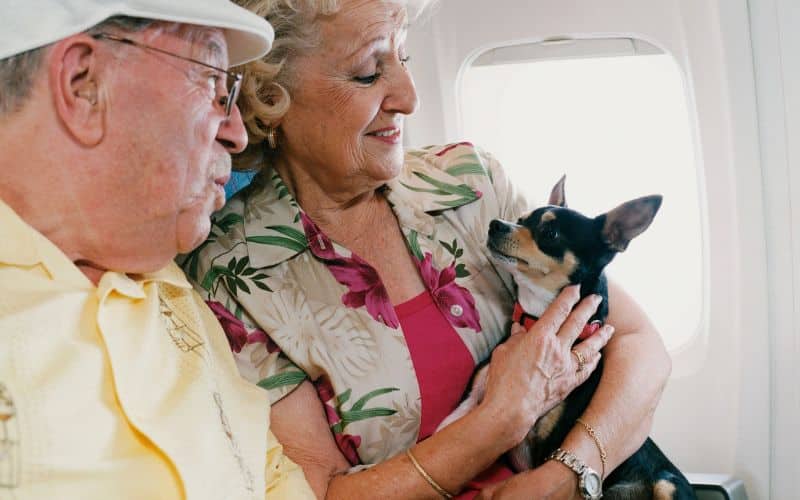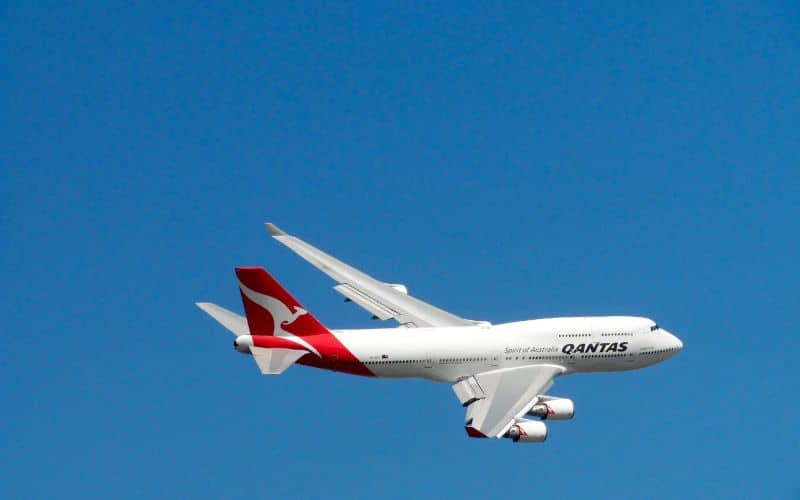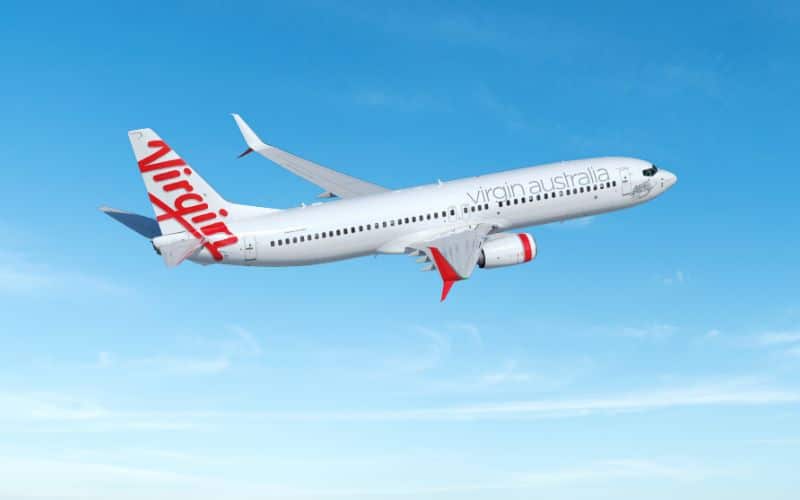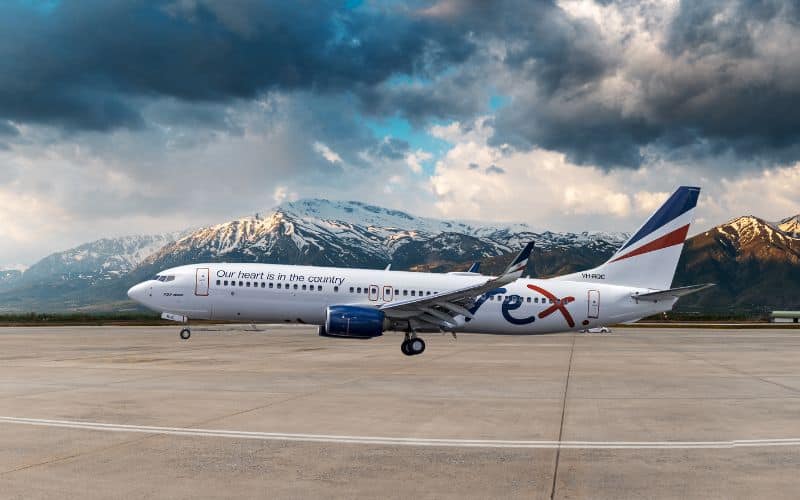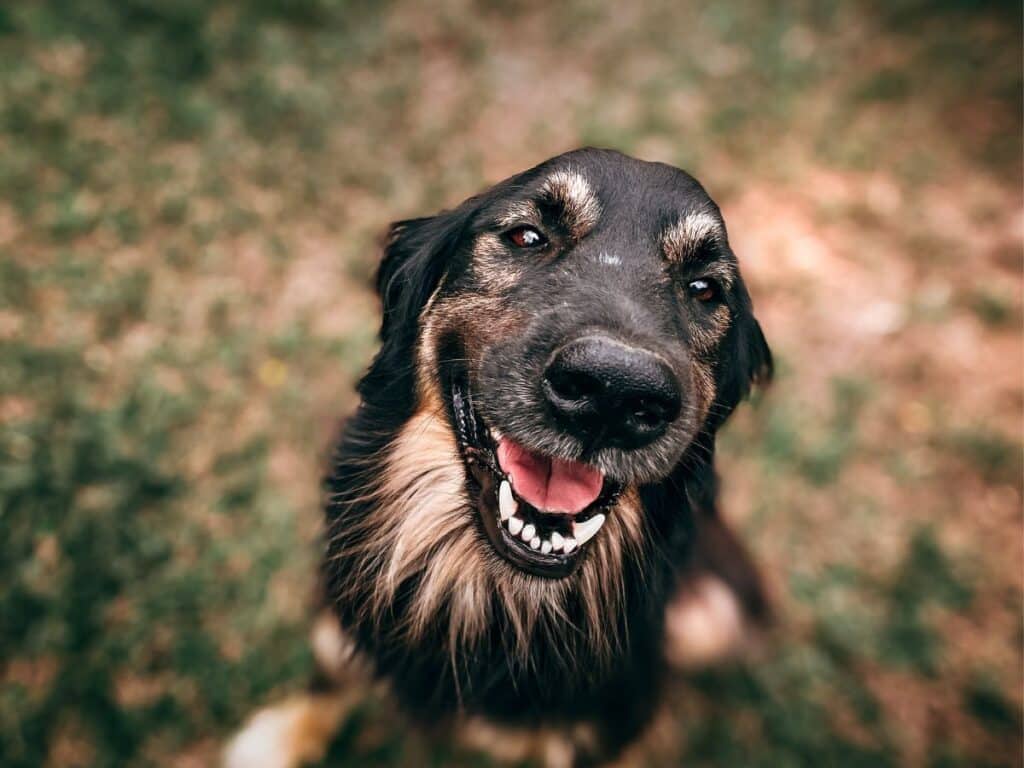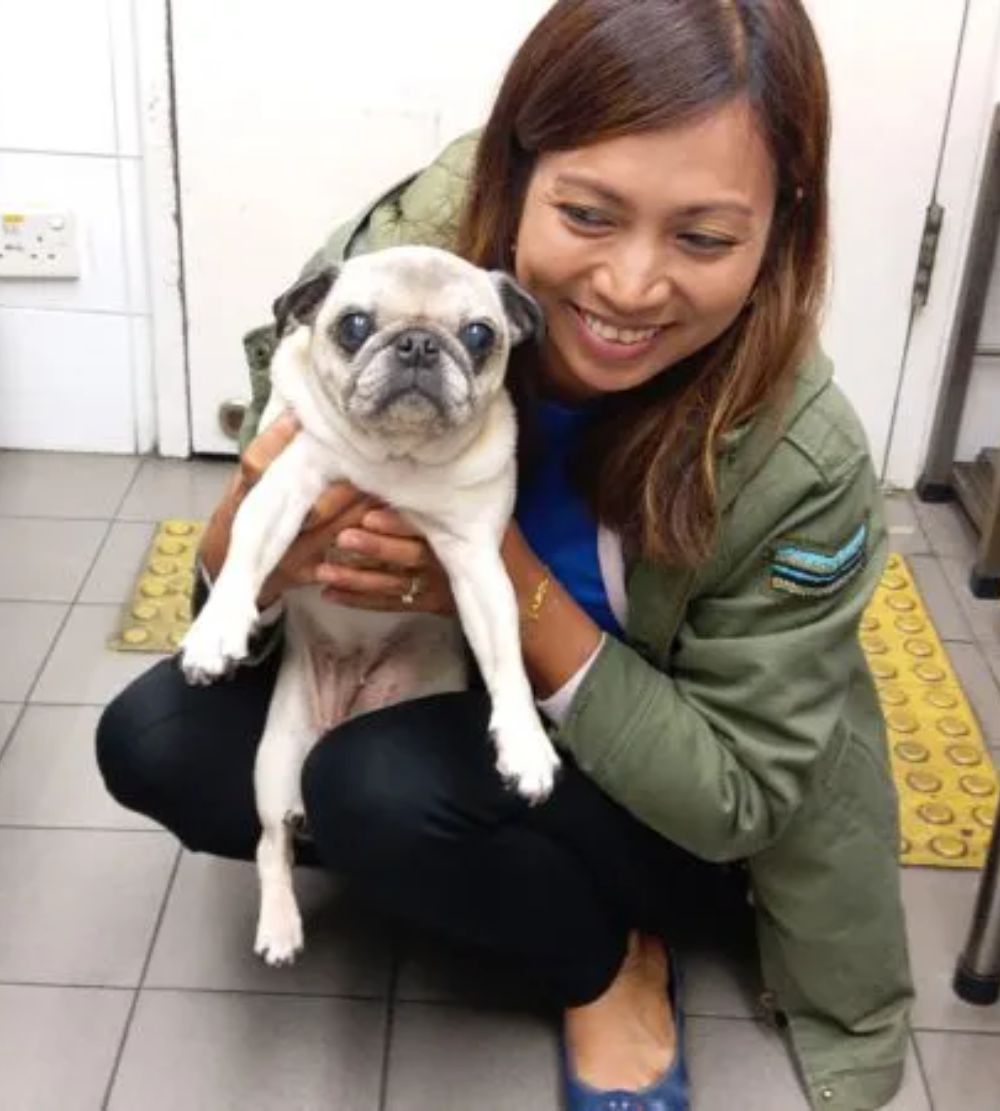Are you wondering, Can you take your dog on a plane in Australia? Yes, you can take your dog on a plane in Australia, but there are specific rules and airline regulations you must follow. Each airline has its own rules and restrictions regarding pet transporting into Australia. Most airlines determine whether dogs travel in the cabin or cargo based on their size and breed.
Although the Civil Aviation Safety Authority (CASA) permits in-cabin travel for pets under certain conditions (if airline allows it), no regular Australian airline currently allows dogs in the passenger cabin. As a result, most dogs must travel in the aircraft’s cargo hold. Fortunately, hundreds of thousands of pets safely travel this way each year, provided they are vet-cleared and crate-trained. The cargo areas used for pet transport are temperature-controlled and secure.
Australia is pet-friendly, and travelling with your dog can be a rewarding experience. However, it requires careful planning and preparation. In this article, we’ll walk you through everything you need to know about flying with your dog in Australia. We’ll also break down the pet travel policies of major domestic and international carriers, including Qantas, Virgin Australia and Rex. With the right steps, your dog can travel comfortably and explore Australia by your side.
Can Dogs Fly in the Cabin to Australia?
In December 2021, the Civil Aviation Safety Authority (CASA) approved pets flying in aircraft cabins if airlines allow it. However, till July 2025, no Australian domestic or international airline has yet allowed dogs or cats to fly in the cabin to Australia. While travelling to the USA or Europe, it is common to see pets flying alongside their owners in the cabin. In Australia, only trained service or assistance animals are permitted in the cabin. All other pets must travel safely in the temperature-controlled cargo hold, which is designed for their comfort. Airlines like Qantas, Virgin Australia, and Rex currently allow pet travel in cargo under specific size and weight restrictions.
This is set to change, with Virgin Australia announcing in March 2024 that it will soon become the first Australian airline to allow small dogs and cats to travel in the cabin with their owners on select domestic flights. Pets will need to remain in approved carriers placed under the seat and will be limited to specific rows. The service is still pending regulatory approval, but once cleared, it promises to make pet travel significantly more convenient for Australians. Stay tuned as the country moves toward a more pet-friendly future in air travel.
Which Airlines Allow Dog Travel in Australia?
When flying with your pets to Australia, it is important to understand the rules and options available for pet travel. In-cabin pet is generally not permitted except for assistance dogs, so most pets must travel in the cargo hold. Airlines like Qantas, Virgin Australia, and Rex offer safe and regulated cargo services for domestic and international flights.
Knowing each airline’s specific policies including weight limits, carrier requirements, and necessary pet documentation will help ensure a smooth and comfortable journey for your furry friend. Here’s a detailed comparison of the main airlines that accommodate pet travel across Australia.
Qantas
Qantas is the most popular and trusted airline for pet travel in Australia, offering comprehensive domestic and international pet transport services. Qantas Pet travel prioritise your pet’s health, safety, and comfort throughout the journey. Only service dogs and assistant dogs are allowed in the cabin; all other pets must fly in the cargo hold, which is pressurised and climate-controlled to maintain similar temperature and noise levels as the passenger cabin.
Pets must be transported in IATA-approved pet carriers that meet size and safety requirements. The combined weight of the pet and crate should not exceed 65 kilograms; otherwise, special freight arrangements will be necessary. Qantas recommends that pet owners book their pet’s flight well in advance since there are restrictions on which flights allow pets. Pet owners must also provide valid Pet health certificates, vaccination records, and microchip details to comply with Australian pet transport regulations.
With a team of dedicated staff trained in pet travel logistics and animal welfare, Qantas pet travel ensures all furry passengers experience a smooth and stress-free flight. Their reliable services and strict adherence to aviation safety rules make Qantas the airline of choice for pet owners across Australia.
Virgin Australia
Virgin Australia offers pet travel options on select domestic flights with strict compliance to pet transport regulations. Dogs must be at least eight weeks old, in good health, and treated for parasites before flying. Pets must travel in approved carriers that comply with size and weight restrictions, with the total weight of the pet plus carrier not exceeding 65 kilograms.
Vergina Pet travel services require pet owners to submit all necessary documentation, including pet health certificates and vaccination records, to ensure the pet’s well-being during transit. The airline emphasizes pet safety by following specific airline rules and providing a secure environment for pets throughout their journey.
REX Airline(Regular Express)
REX Airlines permits pets on select regional domestic flights, but unlike Qantas and Virgin Australia, pets travel as excess baggage rather than in the cabin or a dedicated cargo hold. This means pets are handled like checked luggage and subject to applicable weight and size restrictions.
Due to the smaller size of REX’s aircraft, the combined weight limit for a pet and its crate is capped at 30 kilograms. This limitation is important for owners of larger dogs or bigger carriers to consider. Since airline policies can change, pet owners should always check with REX or a reputable pet transport company for the latest pet travel requirements and carrier specifications before booking.
Airline Requirements for Dog Travel to Australia
The requirements for dog travel vary depending on the airline and the country you’re importing from. But there are specific requirements that are similar across almost all airlines flying to or within Australia, including Virgin Australia, Qantas, and Rex:
1. Your dog must be healthy and fit to travel.
2. Dogs must travel in International Air Transport Association (IATA)-compliant carriers that are appropriately sized and well-ventilated.
3. The combined weight of your dog and the crate must not exceed 65 kilograms.
4. Pets must be microchipped, and the microchip number must be listed on all veterinary and import documents.
5. Airlines often have minimum age requirements, typically at least 8 weeks old for puppies and kittens.
6. Advance quarantine booking is required for dogs imported from overseas.
7. Your dog must not be heavily pregnant or aggressive in behavior.
8. Dogs must have a valid rabies vaccination certificate, and in most cases, must pass a Rabies Neutralising Antibody Tests (RNAT)
9. A health certificate from an accredited veterinarian is required, confirming your dog is healthy and fit to fly.
10. An import permit must be obtained from the Biosecurity Import Conditions (BICON) system before travel.
11. Dogs must receive internal and external parasite treatments prior to departure, with treatment details included in the documentation.
12. Pets must arrive at an approved Australian airport that accepts live animal imports.
13. Dogs (except service animals) are not allowed in the cabin and must travel in the airline’s pet cargo section.
14. Sedated pets are not accepted by airlines due to health risks during the flight.
Can You Bring All Dogs on Airplanes to Australia?
No, not all dogs are allowed on airplanes to Australia. Certain dog breeds banned in Australia are prohibited from being imported or transported by air in australia. These restricted breeds are not permitted to fly either domestically or internationally. The banned dog breeds include:
- American Pit Bull Terrier
- Dogo Argentino
- Japanese Tos
- Fila Brasileiro
- Perro de Presa Canario
- Argentinean fighting dog
- Czechoslovakian Wolfdog
- Kunming wolfdog
- American Staffordshire Terrier
Where Do I Drop Off and Pick Up My Dog?
The drop-off and pick-up points for flying with dogs in Australia are usually located in the airport’s cargo terminal. However, the specific location can vary depending on the airline and airport. For domestic flights, pet owners should arrive at the designated cargo area or pet travel desk at least 1–2 hours before departure. For international flights, it’s best to arrive 3–5 hours early, as required by the airline and cargo terminal. Arriving early gives airline staff time to verify your dog’s health certificate, inspect the travel crate, and ensure all safety and compliance standards are met including crate ventilation, secure locking, and stress-minimizing features.
On arrival, pet clearance may take time due to customs inspections, biosecurity checks, and ground handling processes. We recommend arriving 60–90 minutes after the flight lands, especially for international flights. Dogs imported to Australia are subject to strict veterinary standards, and delays may occur during quarantine clearance to ensure all import regulations are properly followed before your pet is safely released into your care.
Also Check Out: What Is the Total Cost of Bringing a Dog to Australia?
Conclusion
To conclude, you can take your dog on a plane in Australia, but it is essential to be well-prepared and fully informed about the specific airline requirements, pet documentation, and government regulations that apply to your situation. Your furry friend’s safety and comfort should always be your top priority, whether you are travelling domestically or internationally. The process can be complex, involving steps like obtaining health certificates, preparing pet documentation, meeting vaccination and microchipping requirements, booking quarantine when necessary, and following airline-specific pet policies. Whether your dog travels in-cabin, typically for certified service animals, or in the cargo hold, you’ll need to choose a reputable pet transport service, prepare vaccination records and health checks, and ensure proper crate training.
It is also important to comply with Australian Customs, quarantine, and biosecurity regulations and arrange advance quarantine bookings if required. If the process feels overwhelming, our professional pet relocation company can manage everything from health certification and documentation to customs clearance and quarantine arrangements, so you can focus on reuniting safely with your furry friend. Whether relocating interstate or flying internationally, trust us to prioritize your dog’s health and happiness throughout the journey.
Pet Travel with Our Expert Services!Ready to embark on a journey with your beloved dog? Ensure a seamless travel experience with our expert pet relocation services. From navigating airline regulations to providing top-notch care, we handle every detail, ensuring your pet’s comfort and safety throughout. Trust us to make your pet’s journey to Australia stress-free and enjoyable. Contact us today to start planning your pet’s adventure! |
Frequently Asked Questions
Which airlines allow pets in cabins in Australia?
Qantas Airlines allows service or assistance dogs in a cabin. These dogs must be trained to assist or perform tasks for the pet owner with disabilities.
Can I take my dog on a Jetstar flight?
No, Jetstar is not equipped for pet transportation. Instead of Jetstar, you can book a flight from Qantas, REX, and Virgin Australia Airlines.
What type of pet crate should I use for air travel in Australia?
Your pet must be transported in an approved pet carrier or crate that meets IATA standards. These carriers should be well-ventilated, secure, and appropriately sized for your pet.
Do I need to microchip my dog before travelling to Australia?
Yes, most airlines and Australian authorities require that your dog is microchipped, and it should be registered with your contact information.
How far in advance should I plan for pet travel in Australia?
Planning well in advance is important for pet travel to Australia. It's recommended to start preparations at least seven months before your intended travel date as there are a lot of requirements to meet, like health certificate, import permit, vaccinations, etc.
How much does it cost to fly a dog in Australia?
The cost of flying a dog in Australia varies based on factors like the airline, route, size, and breed of your dog. Domestic flights for small dogs generally range from $80 to $200, while larger dogs can cost between $300 and $500. For international flights, the cost typically falls between $500 and $3,000 or more, depending on the destination and additional services required.

